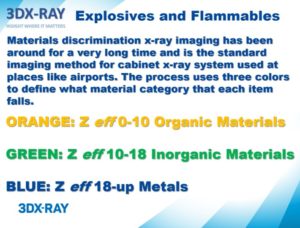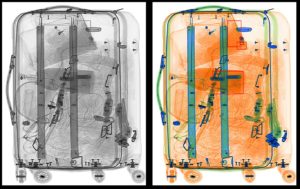Portable materials discrimination for x-ray systems
08 August 2022
Our portable materials discrimination X-ray systems can differentiate between metals, inorganic and organic materials. It allows security specialists to identify explosives, guns, knives and other threats.
Most portable x-ray systems use grey scale (black and white) imaging for materials discrimination. We use a three-colour atomic number (Zeff) system. This is far superior to the standard organic, inorganic, and metals imaging buttons on other portable systems.
We can even identify organic and inorganic material behind solid steel.
Our LS1 and LS3 rely on our IGEN x-ray generator to do this. IGEN is a constant potential x-ray generator. It provides a stable x-ray output that can raise or lower the x-ray energy. It also uses a substantially improved focal spot size and beam angle.
Most other systems use pulsed x-ray sources. These produce far less accurate materials images.
Zeff materials discrimination imaging needs both high and low energy measurements. The IGEN achieves this without filters or wireless controllers. These capabilities are built into its rugged, lightweight package.
Portable materials discrimination
You need to understand colours in this context. The colours are based on the Zeff number. Zeff is the average effective atomic number of any material. The three standard colours are orange, green, and blue. Anything with an atomic number from 0-10 is considered “organic”. This may confuse people who work with explosives. They sometimes classify “organic” as explosives with “carbon” in their chemical formula.
To an x-ray system “organic” organic means an average effective atomic number 0-10. This is displayed as orange. For example, to an explosive expert explosives Ammonium Nitrate (AN) is classified “Inorganic.” But to an x-ray system AN does show orange – i.e. organic.
It is a misunderstanding to think all explosives are organic and turn orange. The following images show you how real explosives appear in our accurate “materials discrimination” imaging.

So, materials with an average atomic number from 10-18 turn green – “inorganic.” Anything above 18 are classed as “metals” and turn blue.

Materials discrimination
 |
Metal pipe bombs, knives, guns, ammunition, hand grenades, nails, ball bearings, steel, iron, copper |
 |
Aluminium, salts, chlorates, black powder, Al powder, calcium nitrate, clay plumbers’ putty, clay |
 |
Most explosives, water, wood, paper, food, soda, milk, flammable liquids |
Terrorists often try to hide bombs, weapons and contraband behind metal shields. A common idea is to shield them, so the x-ray can’t see. To beat this our“Probe” feature virtually peels away even dense blocking layers. This allows operatives to examine anything behind them.
Our portable materials discrimination in X-Ray security system can identify organic and inorganic material behind these layers. This is NOT like the standard organic, inorganic, and metals imaging buttons on cabinet x-rays.
For more information on portable materials discrimination for x-ray systems click here
For information on ThreatScan®-AS1, a portable amorphous silicon x-ray security click
For information on ThreatScan®-LS1, a portable amorphous silicon x-ray security click
For information on ThreatScan®-LS3, a portable amorphous silicon x-ray security click

